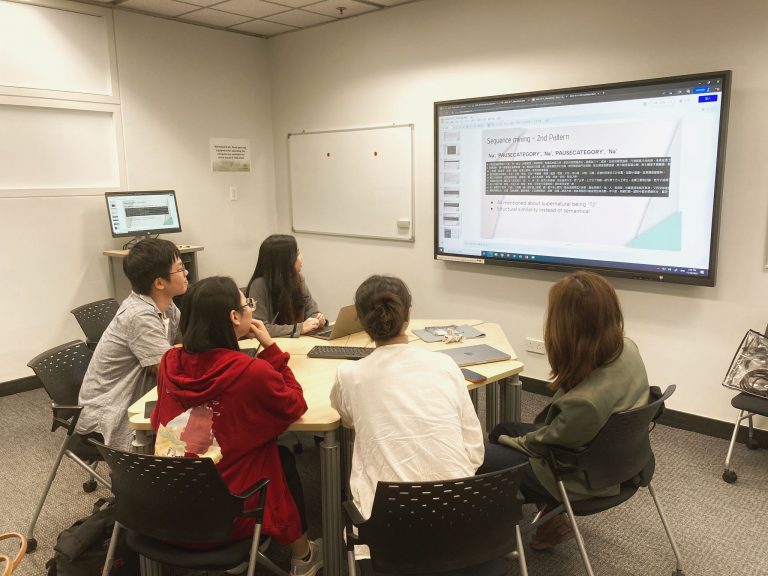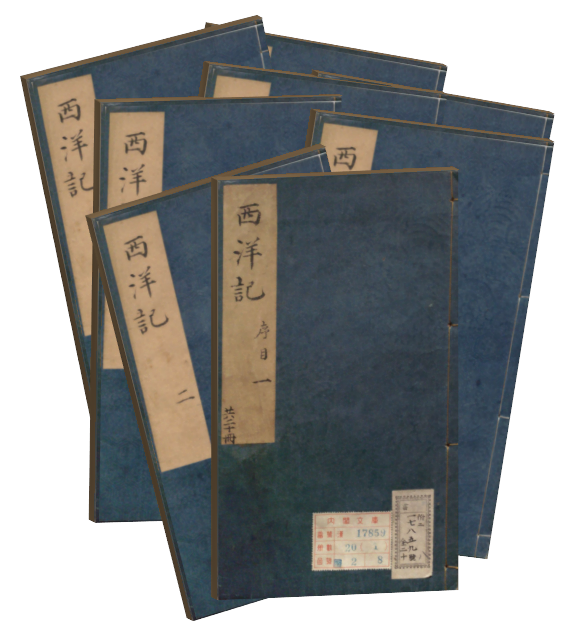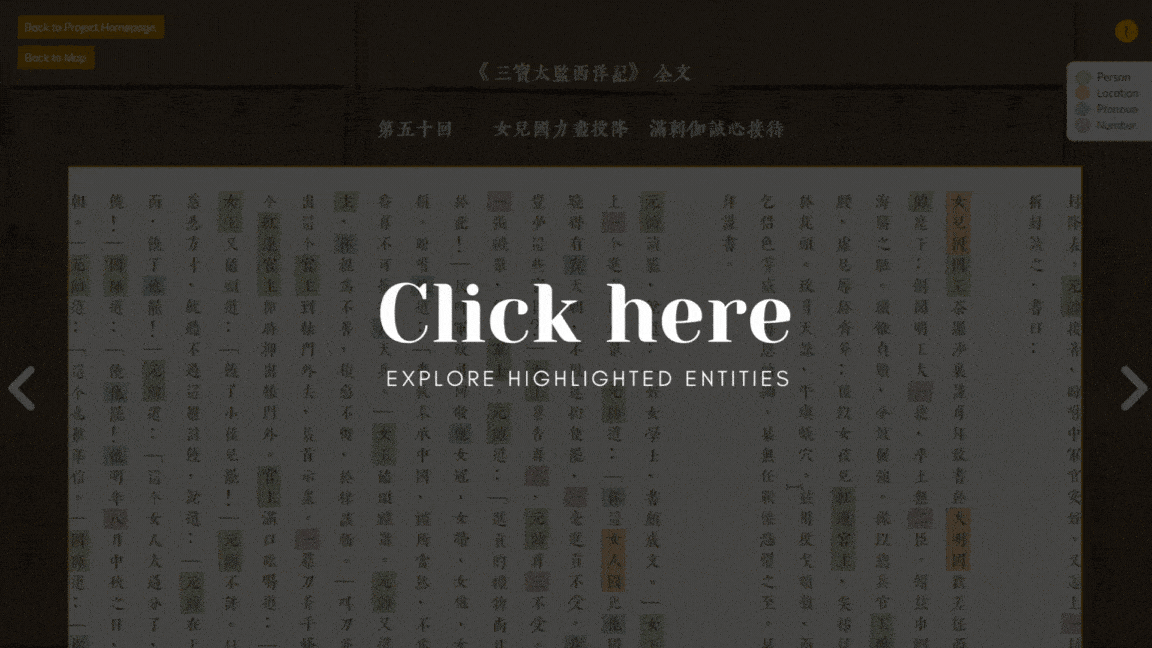A Study of “Zheng He’s Voyages to the Western Sea” 《三寶太監西洋記》
Digital Humanities Project

This project received the Digital Humanities Seed Funding, which is utilized for students recruitment. The two recruited students (left 2: LAU Ming Kit Jack from BEng in Computer Engineering; left 3: YIP Sau Lai Sherry from BSc in Data Science and Technology) actively participated in the project during the fall semester of 2023, contributing their efforts from September 2023 to January 2024.
About This Project
Led by Prof. Jin Huan, this project focuses on conducting research on the topic “Rhetorical Formula and Linguistic Style in Early Chinese Novel – A Study of Zheng He’s Voyages to the Western Sea (三寶太監西洋記)”. During the fall semester of 2023, the project team used a range of methods, including but not limited to text mining, statistical approach to quantitative linguistic analysis and AI methodologies, to investigate the patterns related to vocabulary, syntax, grammar, and discourse on the following three Ming dynasty’s novels:
- 羅懋登《三寶太監西洋記》 (Zheng He’s Voyages to the Western Sea) (1598)
- 吳承恩《西遊記》 (Journey to the West) (1592)
- 羅貫中《三遂平妖傳》 (Three Sui Quelling the Rebel’s Revolt)
By examining the similarities and differences in their linguistics style, we aimed to uncover insights into the rhetorical formula and linguistic style that employed in early Chinese vernacular novels.
Findings
The insights gained from this digital humanities workshop serve as a foundation for pursuing RGC funding and driving further progress in this research. The findings also pave the way towards publishing a scholarly paper. Keep an eye out for Prof. Jin’s future paper, which will provide valuable insights derived from this project.
Meanwhile, we have utilized a selection of our findings to create a network graph to provide visual representation of the character interactions within this novel. Besides, a multi-layered map is created to illustrate Zheng He’s Voyages to the Western Sea in the novel 《三寶太監西洋記》. We have also created pages to display the full text of each chapter, with entities highlighted. You could easily identify the entities of location names, person names, pronouns and numbers in our pages. We hope that this could allow readers to easily identify these entities while reading and facilitates a deeper understanding of the novel.
Let’s view the map, full text of each chapter and the character network graph below – explore the rich narrative and geographical elements of this novel.
About This Novel
“Zheng He’s Voyages to the Western Sea”
(Sanbao taijian xi yang ji《三寶太監西洋記》)
First published in late sixteenth century, Zheng He’s Voyages to the Western Sea is one of the early full-length vernacular Chinese novels. It is a story characterized by supernatural and imaginary elements (shenmo xiaoshuo 神魔小說) which revolves around voyages to foreign countries and continents undertaken by the historical figure Zheng He (鄭和) (1371?–1433?).
This entire novel consists of 20 volumes and 100 chapters. Its content is based on historical records, rumors, and miscellaneous notes about Zheng He and the various Western nations at that time. The author imaginatively exaggerates these accounts, creating a fictional “fantasy novel”. In the novel, Zheng He encounters supernatural beings and monsters to the Western sea, establishing diplomatic relations with various nations along the way.

Characters Network Graph
The network graph below provides a visual representation of the character interactions within this novel.
- Each node represents a character. The size of the node is defined by the frequency of appearance of the character.
- The connecting edges depict the relationships and interactions between them.
- The thickness of the edges indicates the strength and frequency of these interactions. More specifically, it represents the intimacy of the pair, with weight defined by the word sum of dialogues between them. Dialogues are first grouped by scene, then for each pair of characters, if they both appear in a dialogue group, the dialogues from either of them in this group will be counted.
The colors of the nodes are assigned as follows:
- Orange: the four main characters
- Yellow: members or external assistants of the voyage team
- Red Series: characters appearing in places visited by the voyage team
- Blue series: characters appearing before the voyage begins (Chapter 1 to Chapter 18)
To simplify the network, only nodes with a weight (i.e. frequency) greater than 40 and edges with a weight (i.e. word sum) greater than 200 are shown. From the graph, you can observe the clusters of characters who frequently engage with one another within the story. Additionally, we can identify pivotal characters who bridge multiple groups, acting as catalysts for significant plot developments. This network graph serves as a tool for understanding the complex dynamics and interplay between the characters, offering insights into the novel’s themes and narrative structure.
Words from Students
“I’ve had a chance to explore and learn so much about this field. As an engineering student, I didn’t know much about digital humanities, so this project was a fantastic opportunity for me to dive in and discover what it’s all about.
Before the project, I already had some basic knowledge about NLP and LLMs, but I didn’t have the chance to put them to use before. Moreover, analyzing an ancient Chinese novel was no ordinary task! I had to conduct extensive literature review and the development of my own methodologies for exploring the book…”
LAU Ming Kit, Jack
Year 4, BEng in Computer Engineering
“This internship was valuable considering the fruitful professional development I gained. Working on such an interdisciplinary project, I developed a sense of the importance of cultivating a broad perspective and practiced how to quickly get familiar with a field outside my area of expertise.
Another benefit is the practical experience of applying theoretical knowledge to real-life problems. Taking programming as an example, I learnt that it requires a combinatory application of problem translation, theoretical logic, and online research skills...”
YIP Sau Lai, Sherry
Year 3, BSc in Data Science and Technology
Project Team
- Prof. JIN Huan (Division of Humanities)
- Dr. Qiuzi GUO (Division of Humanities & Library)
- Holly CHAN (Library)
- LAU Ming Kit, Jack (student from Computer Engineering, HKUST)
- YIP Sau Lai, Sherry (student from Data Science and Technology, HKUST)
- WONG Sze Man, Jenny (student volunteer from Chinese Language and Literature, HKSYU)
What tools we have used?
Here, we would also like to share some of the useful tools that we utilized in this digital humanities project. We hope that our sharing will be beneficial for others in their own projects. If you are working on similar things and find our sharing helpful, please feel free to let us know. We would love to hear about your experiences and feedback. Together, we can make a positive impact in the field of digital humanities, fostering an open and collaborative sharing culture all together.
References
周致中(元)。《異域志》。取自 https://ctext.org/wiki.pl?if=gb&res=972428
萬斯同(清)。《明史》。取自 https://ctext.org/wiki.pl?if=gb&res=410835
趙汝適(1225)。《星諸蕃志》。取自 https://ctext.org/wiki.pl?if=gb&res=520299
費信(1436)。《星槎勝覽》。取自 https://ctext.org/wiki.pl?if=gb&res=99548
馬歡(1451)。《瀛涯勝覽》。取自 https://ctext.org/wiki.pl?if=gb&res=428579
羅懋登(1598)。《三寶太監西洋記》(明萬曆廿六戊戍年三山道人刻本)。取自 http://open-lit.com/html/lit/218/
趙景深(1937)。三寶太監西洋記。在《小說閒話》(頁153-207)。上海 : 北新書局。
鄭鶴聲、鄭一鈞(1980)。鄭和下西洋資料彙編。濟南:齊魯書社。
張俊彥(1981)。中古時期中國和阿拉伯的往來: 兼論中國和阿曼的關系。北京大學學報,1981(3)。 doi:CNKI:SUN:BDZK.0.1981-03-006.
紀念偉大航海家鄭和下西洋580週年籌備委員會、中國航海史硏究會(1985)。鄭和研究資料選編。北京:人民交通出版社。
張火慶(1989)。「三寶太監西洋記」的人物角色與旅途反應。興大中文學報,2,頁133-155。https://core.ac.uk/download/pdf/41688459.pdf
張云(1999)。《西游記》中“女兒國”的真面目。語文世界, 1999(5),頁39。 doi:CNKI:SUN:YWSJ.0.1999-05-047.
許永璋(2001)。中國載籍中非洲史資料匯編問題漫議。西亞非洲, 2001(5),頁51-54, 80。 doi:CNKI:SUN:XYFZ.0.2001-05-015.
吳佩蓉(2007)。小說的衍異:《三寶太監西洋記通俗演義》書寫現象之研究。https://nccur.lib.nccu.edu.tw/handle/140.119/37171
許永璋(2011)。宋代中國對非貿易探討。黃河科技大學學報, 2011(2),頁66-69。 https://doi.org/10.19576/j.issn.1008-5424.2011.02.017
劉紅林(2014)。承擔歷史,開啟文學:論有關「鄭和下西洋」的三篇遊記。世界華文文學論壇,2014(1),頁15-18。
看歷史(2015)。《西游記》裡的女兒國存在嗎? 。初中生學習(高) , 2015(12),頁34-35。doi:CNKI:SUN:CZSK.0.2015-12-025.
趙景深(2016)。《西洋記》與《西洋朝貢》。在江巨榮(編),《趙景深文存》(頁897-901)。上海 : 上海古籍出版社。
劉瓊云(2018)。神魔傳統遇上海外知識 :《三寶太監西洋記》中的世界、敘事與想像。臺大中文學報,62, 頁49-104。
盧緒友(2019)。洪武初年明軍兩逐順帝之戰史地考證。中國邊疆史地研究,29(2),頁145-153, 216。 doi:CNKI:SUN:ZGBJ.0.2019-02-014
田國民(2020)。明代「鄭和下西洋」故事跨文本研究〔碩士論文,黑龍江大學〕。https://doi.org/10.27123/d.cnki.ghlju.2020.000605
邵毅平(2021)。羅懋登的西洋。中華文史論叢,141,頁311-405。https://doi.org/10.16837/j.cnki.1002-0039.2021.01.012



